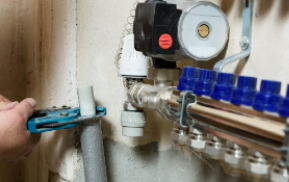Heat sources :
In a petroleum derivative power plant utilizing a steam cycle for power age, the essential hotness source will be the burning of coal, oil, or flammable gas. Now and again result in fuel, for example, the carbon monoxide-rich off-gasses of a coke battery can be singed to warm a heater; biofuels like bagasse, where monetarily accessible, can likewise be utilized. In a thermal energy station, boilers called steam generators are warmed by the hotness created by atomic parting.
Where an enormous volume of hot gas is accessible from some interaction, a hotness recuperation steam generator or recuperation evaporator can utilize the hotness to deliver steam, with practically no additional fuel devoured; such an arrangement is normal in a joined cycle power plant where a gas turbine and a Boiler Servicing Coventry are utilized. In all cases the consuming thing waste gases are free of the working fluid of the steam cycle, making these systems occurrences of outside start engines.
Materials :

The strain vessel of a heater is normally made of steel (or combination steel), or generally of fashioned iron. Hardened steel, particularly of the austenitic kinds, isn’t utilized in wetted portions of boilers because of consumption and stress erosion cracking. Nonetheless, ferritic tempered steel is routinely used in superheater fragments that will not be introduced to gurgling water, and electrically-warmed treated steel shell boilers are permitted under the European “Strain Equipment Directive” for the production of steam for sanitisers and disinfectors.
In live steam models, copper or metal is regularly utilized in light of the fact that it is all the more effortlessly manufactured in more modest size boilers. By and large, copper was regularly utilized for fireboxes (especially for steam trains), on account of its better formability and higher warm conductivity; be that as it may, in later occasions, the exorbitant cost of copper frequently settles on this an uneconomic decision and less expensive substitutes (like steel) are utilized all things considered.
For a large part of the Victorian “time of steam”, the main material utilized for boiler making was the most noteworthy grade of created iron, with getting together by riveting. This iron was frequently gotten from expert ironworks, for example, those in the Cleator Moor (UK) region, noted for the great of their moving plate, which was particularly appropriate for use in basic applications like high-pressure boilers. In the twentieth century, plan practice moved towards the utilization of steel, with welded development, which is more grounded and less expensive and can be manufactured all the more rapidly and with less work. Created iron boilers erode undeniably more leisurely than their current steel partners, and are less helpless to restricted pitting and stress-erosion. That makes the life span of more seasoned fashioned iron boilers far better than that of welded steel boilers.
Cast iron might be utilized for the warming vessel of homegrown water radiators. Albeit such warmers are typically named “boilers” in certain nations, their motivation is as a rule to deliver heated water, not steam, thus they run at low strain and attempt to abstain from bubbling. The weakness of cast iron makes it unfeasible for high-pressure steam boilers.




